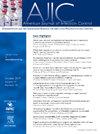Facility-level antibiotic prescribing rates and the use of antibiotics among nursing home residents
IF 3.8
3区 医学
Q2 INFECTIOUS DISEASES
引用次数: 0
Abstract
Background
The high frequency of antibiotic use in US nursing homes is a public health concern. Facility-level prescribing patterns may provide a measure for antibiotic stewardship targeting.
Methods
An analysis of 2018-2019 data from linked files from the Centers for Medicaid and Medicare was conducted. Multilevel generalized linear models were used to calculate odds ratios for antibiotic receipt for calendar year 2019 using the 2018 facility prescribing rate.
Results
In 2019, 186,274 (19%) residents were prescribed an antibiotic. The most frequently prescribed class of antibiotics was cephalosporins (26%), and the average duration of antibiotic use was 9 days. Residents who were dually eligible for Medicare and Medicaid had 37% increased odds of antibiotic receipt (all adjusted odds ratio (aOR): 1.37, 95% confidence interval [CI]: 1.35, 1.39). The 2018 facility prescribing rate was associated with 14% increased odds of antibiotic receipt in 2019 in NHs in the medium (11.9%-20.2%) prescribing category (all aOR: 1.14, 95% CI: 1.11, 1.17) and 36% increased odds of antibiotic receipt in NHs in the high (> 20.3%) prescribing category (all aOR: 1.36, 95% CI: 1.32, 1.40) when compared with the lowest (0%-11.8%) prescribing category.
Conclusions
Antibiotic stewardship strategies should target nursing homes with high antibiotic prescribing rates and high populations of dually eligible patients to improve care in this population.
养老院居民的抗生素处方率和抗生素使用情况。
背景:美国养老院的抗生素使用频率很高,这是一个公共卫生问题,也是抗菌药物管理工作的目标。设施层面的处方模式可为抗生素管理目标的确定提供衡量标准:对来自医疗补助中心和医疗保险中心的四个链接文件中的 2018 年和 2019 年数据进行了分析。采用多层次广义线性模型,在控制设施和个人水平因素的情况下,使用 2018 年设施处方率计算 2019 日历年接受抗生素的几率比:2019年,186274名(19%)研究居民被处方抗生素。最常处方的抗生素类别是头孢菌素类(26%),抗生素的平均使用时间为 9 天。符合医疗保险和医疗补助双重资格的居民接受抗生素治疗的几率增加了 37%(全部 aOR:1.37,95%CI:1.35,1.39)。与最低(0-11.8%)处方类别相比,2018 年设施处方率与中等(11.9-20.2%)处方类别的养老院在 2019 年接受抗生素的几率增加 14% 相关(所有 aOR:1.14,95%CI:1.11,1.17),与高处方类别(>20.3%)的养老院接受抗生素的几率增加 36%相关(所有 aOR:1.36,95%CI:1.32,1.40):结论:抗生素管理策略应针对抗生素处方率高、双重资格患者多的养老院,以改善该人群的护理。
本文章由计算机程序翻译,如有差异,请以英文原文为准。
求助全文
约1分钟内获得全文
求助全文
来源期刊
CiteScore
7.40
自引率
4.10%
发文量
479
审稿时长
24 days
期刊介绍:
AJIC covers key topics and issues in infection control and epidemiology. Infection control professionals, including physicians, nurses, and epidemiologists, rely on AJIC for peer-reviewed articles covering clinical topics as well as original research. As the official publication of the Association for Professionals in Infection Control and Epidemiology (APIC)

 求助内容:
求助内容: 应助结果提醒方式:
应助结果提醒方式:


